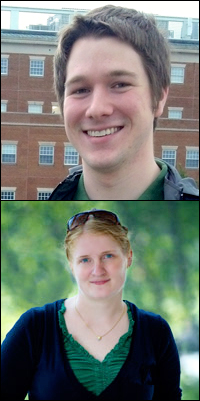News Story
Up In the Air: Does Fracking Create More Pollution Now than Using Natural Gas Will Prevent Later?

A CMAQ model showing the location of shale (red) and wells (white).
Does the process of hydraulic fracturing (“fracking”) create more air pollution than using the natural gas it collects will prevent? That’s the question Department of Chemical and Biomolecular Engineering (ChBE) graduate student Tim Vinciguerra and his research partner, Department of Atmospheric and Oceanic Science (AOSC) graduate student Linda Hembeck, hope to answer.
The University of Maryland Council on the Environment (ConE) recently awarded the pair a Green Fellowship for Collaborative Research on the Environment to support their study, “Interfacing Air Quality and Chemical Engineering: Evaluating the Impacts on Health and Energy Due to Increased Fracking Activities.” Each $10,000 Green fellowship is shared by two principle investigators, who must be graduate students from different disciplines.

Top: ChBE graduate student Tim Vinciguerra. Bottom: AOSC graduate student Linda Hembeck.
Using a series of three computer modeling systems, Hembeck and Vinciguerra will project the level of emissions from fracking and other sources in the year 2020. This data will be used to simulate how the emissions will move and react based on the terrain and weather in a region of the eastern U.S. where fracking is currently underway. The study's results will predict the positive or negative effects on the economy, humans, livestock, and agriculture, and identify whether there is a “tipping point” at which natural gas extraction through fracking becomes a liability.
Vinciguerra, advised by ChBE professor and chair Sheryl Ehrman, says the special project is related to his dissertation work. “My research is air quality focused,” he explains. “I look at trends of pollutants and determine their sources…I also do emissions modeling.”
In the ConE Green study, Vinciguerra will use that expertise to collect information on the current emissions levels in the target regions. He will adjust the data, known as an emissions inventory, based on location and source to project conditions in the year 2020. The information will then be transferred to a modeling system called SMOKE that applies it to a grid.
Hembeck will import Vinciguerra’s SMOKE data into another modeling system called CMAQ, which uses the same grid scale. CMAQ tracks how the emissions react over time based on meteorology and chemical kinetics data. She will run its results through a final simulation called BenMAP to determine the projected health and economic consequences of the emissions—positive or negative—in the target regions.
“BenMAP looks at changes in ozone and particulate matter to determine health benefits, and then it assigns a dollar value based on mortality and morbidity rates,” Vinciguerra explains. “We will compare our projected fracking and natural gas conversion scenario to an as-is scenario to determine these differences.”
The study will eventually expand to include all areas on the Appalachian basin that are candidates for future fracking sites. It may also one day recruit collaborators from additional disciplines who can provide perspectives on other potential fracking-related issues, such as groundwater contamination and geological instability.
For more information:
Visit the University of Maryland Council on the Environment web site
Read Con-E’s announcement of the fellowship
Published February 5, 2014









